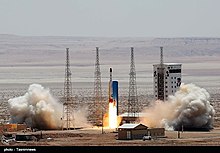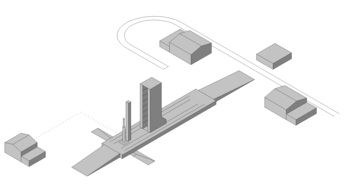| Revision as of 16:12, 28 January 2024 edit2a02:908:4c8:2580:c070:d1ea:787d:d5de (talk) →Development phase (2016-present)← Previous edit | Revision as of 16:19, 28 January 2024 edit undoHosortyr (talk | contribs)Extended confirmed users991 edits Simorgh specified for 250kg to 500km.Tags: Reverted Visual edit: SwitchedNext edit → | ||
| Line 17: | Line 17: | ||
| {{Infobox rocket/Payload | {{Infobox rocket/Payload | ||
| | location = ] 500 km | | location = ] 500 km | ||
| | mass = {{cvt|250|kg}}<ref>{{Cite web |date=2017-07-28 |title=Iran launches Simorgh satellite carrier from Imam Khomeini Space Center |url=https://en.mehrnews.com/news/126769/Iran-launches-Simorgh-satellite-carrier-from-Imam-Khomeini-Space |access-date=2024-01-28 |website=Mehr News Agency |language=en}}</ref> | |||
| | mass = {{cvt|150|kg}} | |||
| }} | }} | ||
Revision as of 16:19, 28 January 2024
Iranian expendable launch vehicle The Simorgh satellite launch vehicle launching on it's first orbital test flight on 27 July 2017. The Simorgh satellite launch vehicle launching on it's first orbital test flight on 27 July 2017. | |
| Function | Small-lift space launch vehicle |
|---|---|
| Country of origin | |
| Size | |
| Height | 26.5 m (87 ft) |
| Diameter | 2.4 m (7 ft 10 in) first stage, 1.5 m (4 ft 11 in) second stage |
| Mass | 87 t (192,000 lb) |
| Stages | 2 |
| Capacity | |
| Payload to LEO 200 km | |
| Mass | 800 kg (1,800 lb) |
| Payload to LEO 500 km | |
| Mass | 250 kg (550 lb) |
| Associated rockets | |
| Family | Derived from Safir |
| Launch history | |
| Status | Under development |
| Launch sites | Imam Khomeini Space Launch Terminal |
| Total launches | 5 or 6 (+1 suborbital) |
| Success(es) | 1 (+1 suborbital) |
| Failure(s) | 4 or 5 |
| First flight | 19 April 2016 (suborbital) 27 July 2017 (orbital) |
| First stage | |
| Height | 17.8 m |
| Diameter | 2.4 m |
| Powered by | 4 × Shahab-5 + 4 verniers |
| Maximum thrust | 1,590 kN (360,000 lbf) |
| Burn time | 120 seconds |
| Propellant | N2O4 / UDMH |
| Second stage | |
| Diameter | 1.5 m |
| Powered by | 4 × R-27 Zyb |
| Maximum thrust | 71.6 kN (16,100 lbf) |
| Burn time | 320 seconds |
| Propellant | N2O4 / UDMH |
| Third stage (Optional) | |
| Powered by | Saman-1 |
| Maximum thrust | 13 kN (2,900 lbf) |
| Burn time | 40 seconds |
| Propellant | Solid |
| [edit on Wikidata] | |
Simorgh (Template:Lang-fa, Phoenix), also called Safir-2, is an Iranian expendable launch vehicle under development. It is the successor of the Safir, Iran's first space launch vehicle. Its mission is to carry heavier satellites into higher orbit than Safir.
The project was unveiled by Iranian President Mahmoud Ahmadinejad on 3 February 2010, as part of celebrations of the first anniversary of the launch of Omid, the first indigenously launched Iranian satellite, and was launched for the first time on 19 April 2016.
Design
Simorgh is a two-stage liquid-fueled rocket developed from the Safir rocket. It is able to place a 250 kg (550 lb) payload into a circular 500 km (310 mi) low Earth orbit (LEO). It is also the first Iranian rocket that can place multiple payloads into orbit (e.g., one main payload and several secondary cubesats). In comparison, the Safir was only able to place a 50 kg payload into a 250x375 km elliptic orbit.
The Simorgh rocket is 26.5 metres (87 ft) long, and has a launch mass of 87 tonnes (192,000 lb). Its first stage with a diameter of 2.4 meters is powered by a cluster of four synchronized Safir-1B first-stage engines with four separate turbopumps, each of these engines generating up to 37,000 kilograms-force (360 kN; 82,000 lbf) of thrust. The first stage also utilize a set of four vernier engines sharing a single turbopump used for attitude control and providing an additional 14,000 kgf (140 kN; 31,000 lbf). At liftoff, these engines generate a total 162,000 kgf (1,590 kN; 360,000 lbf) of thrust. The second stage with a diameter of 1.5 meters utilizes a set of four smaller engines similar to the two engines of Safir's second stage. These produce a total 7,000 kgf (69 kN; 15,000 lbf) of thrust.
The Simorgh's total flight time to a 500-530km orbit is between 480 and 495 seconds. The first stage burns for about 102 seconds. Stages separation takes place at an altitude of 90 km and a velocity of 2300 m/s. The fairing shroud is ejected simultaneously to the second stage engines ignition. The satellite is then accelerated to 7400 m/s and injected into its designated orbit.
In contrast to its predecessor Safir, the Simorgh is integrated and assembled vertically on a launch pad located at the Imam Khomeini Space Center. Each stage goes through manufacturing horizontally and is subsequently brought to the launch pad, where final assembly of the stages are completed with the aid of a custom designed service tower.

Saman-1 is a solid-fueled orbital transfer system under development that produces 1,300 kgf (13 kN; 2,900 lbf) of thrust and will be used as an additional upper stage in future.
Reliability
The development of the Simorgh has been marked with difficulties and unreliability of certain sub-systems due to the overcomplexity of its engines and turbopumps. Out of the system's first four launches (two orbital and two sub-orbital launches) there have been three failures, giving the rocket a reliability rating of twenty five percent. There were however, indications of progressive improvements to the design and reliability of the system with each successive launch; with the 2017 launch operating for 120 seconds before failure, the 2019 launch operating 450 seconds before failure, and the 2020 launch operating correctly for 475 seconds out of the 490 seconds of operation required for a successful mission, giving the missions a 25, 92, and 97 percent success rate respectively, indicating a trend of increasing reliability in the design.
Launch history
Development phase (2016-present)
| Flight No. | Date & Time (UTC) | Payload | Outcome | Type | Remarks |
|---|---|---|---|---|---|
| 1 | 19 April 2016 | No payload | Success | Sub-orbital test flight | Launched without third stage. |
| 2 | 27 July 2017 | No payload | Failure | Orbital test flight | Simorgh operated for 136 seconds. Second stage failed. |
| 3 | 15 January 2019 | Payam (named "AUT-SAT" previously) | Failure | Orbital test flight | Simorgh operated for 455 seconds. Third stage failed. |
| 4 | 9 February 2020, 15:45 | Zafar-1 | Failure | Orbital test flight | Simorgh operated for 475 seconds. Satellite reached speed of 6,500 m/s out of the 7,400 m/s required to orbit. First stage operated fully correctly. Second stage failed in latests second of the flight. |
| 5? | 12 June 2021 | Unknown | Disputed launch existence | U.S. official stated "is aware of an Iranian rocket launch failure". Satellite imagery "looked like a launch" occurred. Iran's Telecommunications Minister denied any launch. | |
| 6 | 30 December 2021 | Three research devices | Failure | Orbital test flight | First time Iran launched multiple payloads in the same launch.
Simorgh operated for about 600 seconds (500 seconds for the second stage). Devices didn't enter orbit; reached an altitude of 470 km and a speed of 7,350 m/s, out of the 7,600 m/s required. |
| 7 | 28 January 2024 | Mahda, Keyhan-2 and Hatef-1 | Success | Orbital flight | First successful orbital launch of Simorgh, placed three satellites into a 1100 x 450 km orbit. The launch was just 8 days after the first successful orbital launch of Qaem 100 . |
Gallery
-
 Simorgh during the launch of Payam satellite on 15 January 2021
Simorgh during the launch of Payam satellite on 15 January 2021
-
 Simorgh during launch preparations
Simorgh during launch preparations
-
 Simorgh in its servicing tower
Simorgh in its servicing tower
See also
- Comparison of orbital launchers families
- Comparison of orbital launch systems
- Iranian Space Agency
- Saman-1 (rocket stage)
Other Iranian satellite launch vehicles
References
- "برنامه ثریا ۱۵ خرداد ۱۴۰۱". telewebion.com (in Persian). 2022-06-05. Retrieved 2022-06-25.
- "Iran launches Simorgh satellite carrier from Imam Khomeini Space Center". Mehr News Agency. 2017-07-28. Retrieved 2024-01-28.
- "Simorgh (Safir-2)". Gunter's Space Page. Retrieved 2024-01-28.
- "Iran fails in satellite launch attempt – Spaceflight Now".
- "Iran brags it launched rocket into space... with mouse, turtles & worms". New York Daily News. 2010-02-03. Retrieved 2010-02-03.
- ""سفیر" رسما بازنشسته شد تا "سیمرغ" مهیای سفر فضایی شود/ طلسم استفاده ماهوارهبر ایرانی از سوخت جامد با سریر و سروش میشکند؟ +عکس". مشرق نیوز (in Persian). 2020-01-28. Retrieved 2021-12-30.
- ^ YJC, خبرگزاری باشگاه خبرنگاران | آخرین اخبار ایران و جهان | (2021-12-31). "پرواز دوباره سیمرغ/ ماهوارهبر سیمرغ چه ویژگیهایی دارد؟" (in Persian). Retrieved 2022-03-27.
- Arrott, Elizabeth (2010-02-03). "Iran Announces New Rockets, Satellites on Space Day". VOA News. Retrieved 2010-02-03.
- ^ "Simorgh First Launch - an Iranian Success or Failure?". 24 April 2016.
- ^ "ماهوارهبر "سیمرغ" چگونه متولد شد؟ +عکس". مشرق نیوز (in Persian). 2020-03-22. Retrieved 2021-06-26.
- Entekhab.ir, پایگاه خبری تحلیلی انتخاب | (December 30, 2021). "برای نخستین بار، سه محموله تحقیقاتی توسط ماهوارهبر سیمرغ با موفقیت به ارتفاع ۴۷۰ کیلومتری پرتاب شد". fa (in Persian). Retrieved 2022-06-29.
- "Iranian DM: Simorgh to Carry Tolou, Mesbah Satellites into Space". Fars News Agency. 2010-02-03. Archived from the original on 2011-11-13. Retrieved 2010-02-03.
- ^ "موشک های ماهواره بر ایران". جنگاوران (in Persian). 2017-08-16. Retrieved 2021-04-15.
- ^ "Safir-2 (Simorgh) IRILV". www.b14643.de. Retrieved 2021-04-15.
- ^ "تحقق ۹۰ درصد اهداف تحقیقاتی در پرتاب ماهواره "ظفر"". defapress.ir. Retrieved 2022-03-16.
- "انجام اولین آزمون زیرمداری سامانه انتقال مداری/آزمون زیرمداری دوم در برنامه بعدی پژوهشگاه فضایی". ایسنا (in Persian). 2021-06-27. Retrieved 2022-06-29.
- Egozi, Arie (2020-06-29). "New Iranian Missile Could Strike Central Europe: Analysis". Breaking Defense. Retrieved 2021-06-26.
- Berger, Eric (2021-06-25). "Rocket Report: China to copy SpaceX's Super Heavy? Vulcan slips to 2022". Ars Technica. Retrieved 2021-06-27.
- ^ Krebs, Gunter. "Simorgh (Safir-2)". Gunter's Space Page. Retrieved 15 January 2019.
- Tawfeeq, Mohammed; Qiblawi, Tamara (15 January 2019). "Despite US warning, Iran launches satellite and fails". CNN. Retrieved 15 January 2019.
- https://spaceflightnow.com/2020/02/10/iran-fails-in-satellite-launch-attempt/ - 11 February 2020
- ^ "بیش از ۹۵ درصد از اهداف طراحی شده برای پرتاب ماهواره ظفر محقق شد". خبرگزاری مهر | اخبار ایران و جهان | Mehr News Agency (in Persian). 2020-02-12. Retrieved 2022-03-16.
- "Iranian Satellite Launched But Fails To Reach Earth's Orbit". RadioFreeEurope/RadioLiberty. Retrieved 2020-02-09.
- "Iran likely had failed rocket launch, preparing for another". AP NEWS. 2021-06-23. Retrieved 2021-12-30.
- "Iran launches rocket into space as nuclear talks continue". www.aljazeera.com. Retrieved 2021-12-30.
- ""Simorgh" satellite carrier successfully launched into space". Mehr News Agency. 2021-12-30. Retrieved 2021-12-30.
- مستند پرواز سیمرغ [The flight of the Simorgh documentary] (in Persian), 2022-01-02, retrieved 2022-03-16
External links
| Iranian space program | |||||||
|---|---|---|---|---|---|---|---|
| Organizations | |||||||
| Space centres | |||||||
| Satellites |
| ||||||
| Launch vehicles | |||||||
| Spacecraft and capsules | |||||||
| Astronomical observatories | |||||||
| Primary spaceports | |||||||
| People |
| ||||||